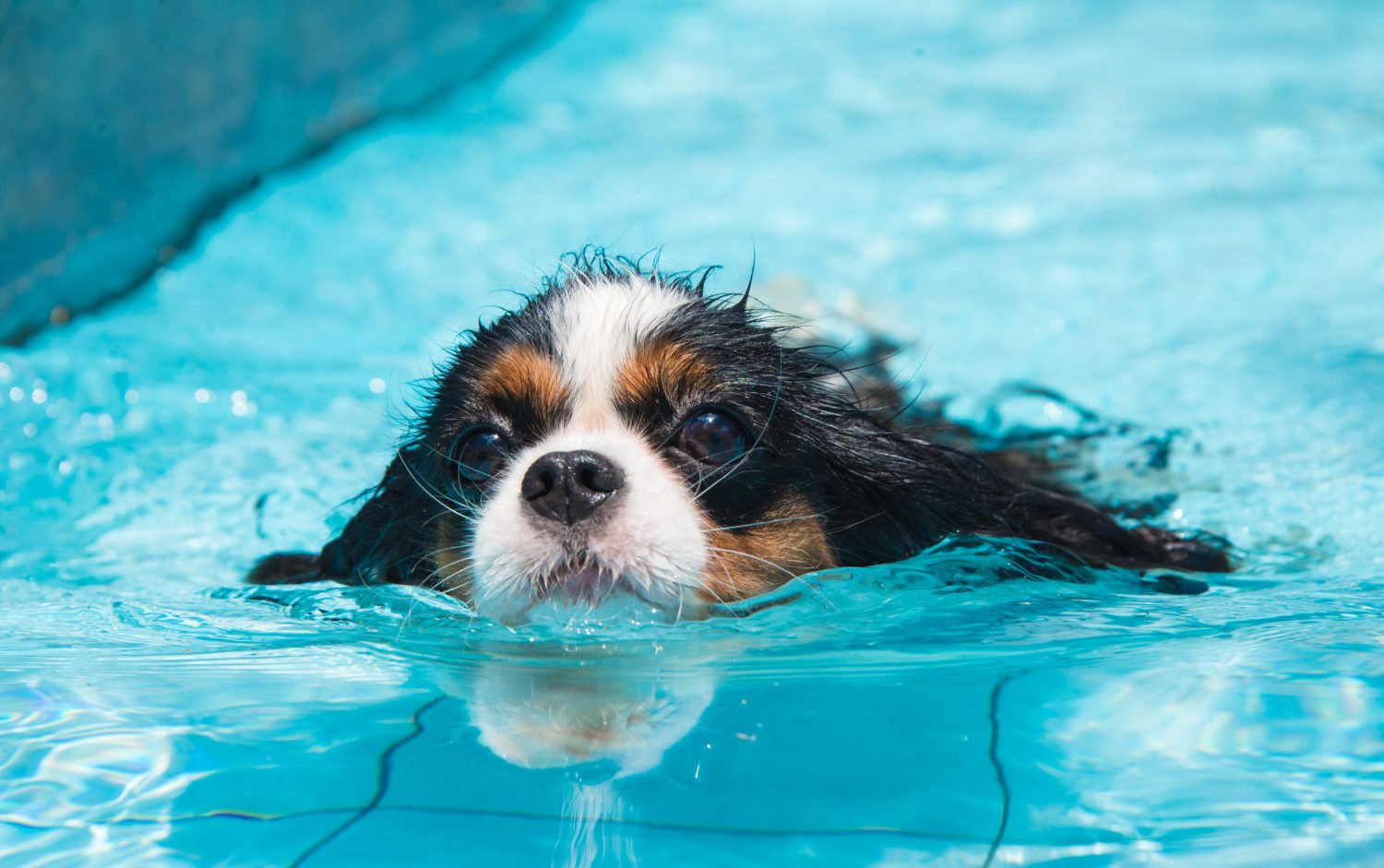Is Swimming Beneficial For Your Dog?
Humans benefit from swimming. On warm days, it offers us beneficial exercise and cooling comfort.
But is swimming healthy for dogs?
Yes, swimming can be a healthy and enjoyable activity for many dogs. It provides numerous physical and mental health benefits. Here are some reasons why swimming is good for dogs:
- Low-Impact Exercise:
- Swimming is a low-impact exercise that is easy on a dog’s joints. It’s particularly beneficial for dogs with arthritis, joint issues, or those recovering from injuries.
- Cardiovascular Fitness:
- Swimming is an excellent cardiovascular exercise that helps improve a dog’s overall fitness and stamina. It engages multiple muscle groups, providing a full-body workout.
- Weight Management:
- Swimming can be an effective way to help dogs maintain a healthy weight or lose excess pounds. The buoyancy of the water reduces the impact on joints, making it suitable for overweight or obese dogs.
- Muscle Building:
- The resistance of the water encourages muscle development. Swimming engages both the hind and front limbs, contributing to balanced muscle development.
- Cooling Effect:
- Swimming is a great way for dogs to cool down, especially in hot weather. It helps prevent overheating, making it a safer exercise option during warm seasons.
- Mental Stimulation:
- Many dogs enjoy the mental stimulation that comes with swimming. It provides a change of scenery and introduces new sensory experiences, contributing to mental well-being.
- Joint Health:
- Swimming can improve joint flexibility and range of motion. It’s particularly beneficial for dogs with conditions like hip dysplasia or arthritis.
- Rehabilitation:
- Swimming is often recommended as part of rehabilitation programs for dogs recovering from surgery or injuries. The water’s buoyancy reduces stress on joints while allowing for controlled movement.
- Socialization:
- Some dogs love swimming as a social activity. It can be an opportunity for them to interact with other dogs or humans in a positive environment.
While swimming is generally safe and beneficial for many dogs, it’s important to consider individual factors:
- Supervision: Always supervise your dog while swimming, especially in natural bodies of water where currents and hazards may be present.
- Comfort Level: Not all dogs are natural swimmers, and some may be hesitant or fearful of water. Gradual introduction and positive reinforcement can help build their confidence.
- Health Conditions: Consult with your veterinarian before introducing swimming, especially for dogs with known health issues. Certain conditions may affect a dog’s ability to swim safely.
- Swimming Skills: Ensure that your dog knows how to enter and exit the water safely. Provide gradual access to deeper areas to allow them to build confidence.
In summary, swimming can be a fantastic and healthy activity for dogs, offering both physical exercise and mental stimulation. However, it’s crucial to consider your dog’s individual characteristics and introduce swimming gradually to ensure a positive experience.
Does Swimming Work Out for Dogs?
Yes, swimming is an excellent form of physical exercise for dogs, providing a full-body workout that engages various muscle groups. Here are some ways in which swimming serves as an effective workout for dogs:
- Cardiovascular Fitness:
- Swimming is a cardiovascular exercise that helps improve a dog’s heart and lung health. It enhances endurance and stamina, contributing to overall cardiovascular fitness.
- Low-Impact Exercise:
- The buoyancy of water reduces the impact on a dog’s joints, making swimming a low-impact exercise. This is especially beneficial for dogs with arthritis, joint issues, or those recovering from injuries.
- Muscle Strength and Tone:
- Swimming engages both the hind and front limbs, promoting the development of muscles in the legs, shoulders, and hips. This helps build strength and tone in a balanced manner.
- Weight Management:
- Swimming is an effective way to help dogs maintain a healthy weight or lose excess pounds. The resistance of the water increases the effort required, making it a calorie-burning activity.
- Joint Health:
- The fluid motion of swimming helps improve joint flexibility and range of motion. It can be particularly beneficial for dogs with conditions such as hip dysplasia or arthritis.
- Rehabilitation:
- Swimming is often recommended as part of rehabilitation programs for dogs recovering from surgery or injuries. It allows controlled movement in a low-impact environment, aiding in the recovery process.
- Cooling Effect:
- Swimming is a great way for dogs to cool down, especially in hot weather. It helps prevent overheating during exercise and provides relief from high temperatures.
- Mental Stimulation:
- Swimming provides mental stimulation as dogs navigate the water, stimulating their senses and providing a change of environment. Mental stimulation is essential for a dog’s overall well-being.
- Socialization:
- For dogs that enjoy water, swimming can be a social activity. It provides an opportunity for positive interactions with other dogs or humans in a fun and engaging environment.
It’s important to note that not all dogs are natural swimmers, and individual preferences and abilities vary. Some dogs may need gradual introduction and positive reinforcement to feel comfortable in the water. Additionally, supervision is crucial to ensure safety, especially in natural bodies of water with potential hazards.
Before starting a swimming regimen, consult with your veterinarian, especially if your dog has underlying health conditions. They can provide guidance on the appropriateness of swimming for your specific dog and offer recommendations based on their health and fitness level.
Does Swimming Benefit Elderly Dogs?
Yes. For senior dogs, swimming is a fantastic pastime as long as the sessions are brief and not too strenuous.
As previously noted, swimming is a low-impact activity that works your dog’s entire body. Exactly what older dogs need is provided.
For their deteriorating muscles and joints, low-impact activities are required. Additionally, it enhances their general conditioning and stops them from losing strength.
Senior dogs deserve to unwind and feel comfortable. Let them swim to ease their suffering.
Even swimming as a kind of physical therapy is advised by some veterinarians for senior dogs, particularly those who have just undergone surgery.
It’s important to keep in mind that not all breeds like swimming, particularly if they are too elderly to do so.
Take good care of your senior dog to prevent ageing symptoms like appetite loss, weight fluctuations, and decreased mobility.
Do Dogs with Hip Dysplasia Benefit from Swimming?
Yes.
Hip dysplasia is a condition in which your dog’s femur, or thigh bone, interferes with their pelvis. Some of its signs and symptoms include limping, soreness, and uneven leg lengths.
Dogs with hip dysplasia can benefit greatly from swimming as exercise. Just be sure to keep it brief and low-key.
Swimming develops your dog’s butt muscles, which support the hip joint’s ball and socket.
It also strengthens your dog’s elbow joints because it is a low-impact, high-resistance exercise.
Keep in mind that excessive swimming may have the opposite effect because it can harm their joints. Additionally, slipping on the ground can result in harm.
Allowing your dog to run on a water treadmill while being supervised by a professional will ensure their safety.
Is Swimming Beneficial for Arthritic Dogs?
Yes.
Your dog’s joints may become inflamed with arthritis, which can be uncomfortable. Their joints’ cartilage deteriorates, causing stiffness and immobility.
Swimming is an excellent kind of exercise for dogs with arthritis because it doesn’t put them under a lot of stress or weight.
Swimming is a fantastic substitute for walking for dogs that have arthritis. It enables individuals to lose weight without jeopardising the condition of their joints.
Does Swimming Harm Dogs?
While swimming is generally a safe and beneficial activity for many dogs, there are certain considerations to keep in mind to ensure their safety and well-being. When done in appropriate conditions and with proper supervision, swimming is not harmful for dogs. However, potential risks and concerns include:
- Supervision:
- Always supervise your dog while swimming, especially if they are new to the activity or if they are swimming in unfamiliar waters. Even dogs that are experienced swimmers can encounter unexpected challenges.
- Water Quality:
- Ensure that the water your dog is swimming in is clean and free from contaminants. Avoid allowing your dog to swim in stagnant or polluted water, as it can lead to skin irritations or infections.
- Overexertion:
- Dogs, especially those new to swimming or not accustomed to regular exercise, can overexert themselves. Monitor your dog’s energy levels, and provide breaks as needed to prevent fatigue.
- Temperature Considerations:
- Be mindful of the water temperature, especially in cold conditions. Hypothermia can be a concern, particularly for dogs with thin coats or those that are not naturally adapted to cold water.
- Hydration:
- Ensure your dog stays hydrated before and after swimming. While they are in the water, they may not have access to drinking water, so it’s important to address their hydration needs before the activity.
- Water Safety Skills:
- Not all dogs are natural swimmers, and some may need time to learn. Gradually introduce your dog to the water, and never force them to swim. Provide positive reinforcement to build their confidence.
- Hazards in Natural Bodies of Water:
- When swimming in lakes, rivers, or oceans, be aware of potential hazards such as strong currents, tides, and underwater obstacles. Choose safe locations for swimming.
- Health Conditions:
- Consult with your veterinarian before introducing your dog to swimming, especially if they have pre-existing health conditions. Certain medical conditions may impact their ability to swim safely.
- Ear Infections:
- Dogs that swim frequently may be more prone to ear infections. Ensure you dry your dog’s ears thoroughly after swimming to prevent moisture from leading to ear issues.
- Pool Chemicals:
- If your dog swims in a chlorinated pool, rinse them off afterward to remove any residual chemicals. Chlorine and other pool chemicals can irritate a dog’s skin and coat.
It’s important to tailor the swimming experience to your individual dog’s needs and abilities. While swimming can be a healthy and enjoyable activity, taking precautions and being attentive to your dog’s well-being will help ensure a positive experience. If you have concerns or if your dog has health issues, consult with your veterinarian for guidance on introducing swimming as part of their routine.
Do All Dogs Have Swimming Skills?
No. While some dogs are naturally good swimmers, others need to be taught how to swim.
Additionally, some people are genetically incapable of learning anything.
They are unable to maintain themselves despite your daily training sessions lasting hours.
Smaller canines that require assistance swimming are the Maltese and Chihuahua.
These tiny pets can readily tyre, thus only brief swimming lessons should be given to them.
Spaniels and Retrievers are two dog breeds that can swim effortlessly, thanks to their powerful and long legs for effortless paddling.
Your Golden Retriever may be bred to swim, but individual swimming skill still differs. Growing up, some people experience a terror of deep water, while others find it to be boring.
Dogs who are older or have infirmities may struggle to swim. Swimming is still less taxing than other hobbies.
The trick is to ease them into swimming. Avoid pressuring them. If not, they could become worn out and stressed out and might not even enjoy it.
Canine Breeds that Enjoy Swimming
Which dog breeds, then, are best suited to navigating deep waters?
Here is a list of canine swimmers.
Canine Labrador
Swimming Labrador Retriever
One of the most well-known breeds in the USA and a common pet in many homes is the Labrador Retriever.
This household dog was developed to hunt ducks and tolerate harsh weather. Because of this, they have an adventurous, sporty, and athletic temperament.
Once you get them in the water, it won’t take long for them to learn how to paddle independently. They might even join you in entertaining pool games.
Swimming Irish Water Spaniel
The Irish Water Spaniel is always referenced while discussing swimming. Like the Lab, this curly breed is a retriever.
They have no fear of anything, not even deep bodies of water, and are curious and gregarious. Their physical characteristics are enhanced by this personality.
You don’t have to worry about water becoming trapped in the Irish Water Spaniel’s fur while they swim because of its water-repellent coat.
breed of standard poodle
The Standard Poodle is very dependable for enjoyable water activities like swimming. This well-bred, inquisitive dog breed is sturdy and powerful enough to paddle with assurance.
The Poodle is adaptable and can live in either a large house or a small apartment. You can either leave them at home alone or take them on vacation with you.
Poodles are excellent company. They excel as therapy dogs and performers. If you enjoy sports, they will pick up the essential knowledge solely to win your favour.
Brazilian Water Dog
Originally bred to operate on trawlers, herd fish, and retrieve nets, these boisterous and playful puppies were intended to be fishermen’s helpers.
As a result, the Portuguese Water Dog will like swimming, dock diving, and boating as well as other water sports on an instinctual level.
They are incredibly bright and obedient, making them simple to train.
This breed is perfect if you’re searching for an active friend to go trekking or to the beach with.
For exercise, how long should a dog swim?
Your dog’s breed, health, level of energy, and swimming prowess all play a role in this.
Dogs who have never been swimming should typically start with ten minutes once a week. Beginners and senior dogs with mobility issues should take note of this.
Dogs with good swimming skills can work out in the pool for around 30 minutes each day. They can work out their entire body during this period and get a fantastic aerobic workout.
Without putting stress on their muscles and joints, it helps them lose a few excess pounds and strengthen their hearts.
An experienced dog can swim for a maximum of one hour every day.
Make sure your dog is trained and ready to swim in the ocean before you let them.
They can spend up to 30 minutes in the water once they are prepared. But make sure you always keep an eye on them.
Don’t ever leave your puppy alone! Even if someone can swim, they still run the risk of drowning.
You need to be mindful of the waves, currents, and potential hazards beneath the sea. As a result, whenever your dog is swimming, keep close by.
Is Swimming a Better Form of Exercise Than Running for dog?
Whether swimming or running is a better form of exercise for a dog depends on various factors, including the dog’s individual characteristics, health status, and preferences. Both swimming and running offer unique benefits, and the choice between the two may vary based on specific considerations:
Benefits of Swimming:
- Low-Impact Exercise: Swimming is a low-impact exercise that is gentle on a dog’s joints. This makes it an excellent choice for dogs with arthritis, joint issues, or those recovering from injuries.
- Full-Body Workout: Swimming engages multiple muscle groups, providing a full-body workout. It promotes muscle development in the legs, shoulders, and hips.
- Cardiovascular Fitness: Swimming is an effective cardiovascular exercise that improves a dog’s overall fitness, stamina, and endurance.
- Cooling Effect: Dogs can regulate their body temperature more effectively in water, making swimming a great option in hot weather to prevent overheating.
- Rehabilitation: Swimming is often recommended as part of rehabilitation programs for dogs recovering from surgery or injuries. The buoyancy of water reduces stress on joints.
- Mental Stimulation: Swimming can offer mental stimulation as dogs navigate the water, providing a change of environment and sensory experiences.
Benefits of Running:
- Land-Based Exercise: Running is a natural and instinctive form of exercise for many dogs. It allows them to engage in their natural behaviors, such as chasing and exploring.
- Cardiovascular Fitness: Running is an excellent cardiovascular exercise that enhances a dog’s endurance, agility, and overall fitness.
- Weight Management: Running can contribute to weight management by burning calories and promoting a healthy metabolism.
- Bonding: Running with a dog can strengthen the bond between the dog and their owner. It provides an opportunity for shared physical activity and interaction.
- Convenience: Running can be easily incorporated into daily routines, providing a convenient way to ensure dogs get regular exercise.
- Energy Release: Running allows dogs to release excess energy, reducing the likelihood of behavioral issues related to boredom or pent-up energy.
Ultimately, the best form of exercise depends on the individual dog’s needs, health status, and preferences. Some dogs may enjoy both swimming and running, and a combination of both activities can provide a well-rounded exercise routine. It’s essential to consider factors such as the dog’s age, fitness level, any existing health conditions, and individual preferences when choosing the type of exercise. Additionally, consulting with a veterinarian can help determine the most suitable exercise plan based on the dog’s specific circumstances.
Where Should I Swim with My Dog?
Because not everyone has a swimming pool at home, not everyone has convenient access to swimming. Here are some suggestions for dog-friendly swimming spots.
Child’s Pool
The least expensive option for taking your dog swimming is in a kiddie pool. It is simple to set up and use anytime you want.
For puppies, small dogs, and older dogs who are unable to swim in deep water, it is also strongly advised.
It’s not just for swimming in a kiddie pool. Additionally, you can use it to bathe them or engage them in other games.
Allowing them to splash while playing Frisbee on a hot summer day might enhance the experience. Additionally, it will keep your dog cool!
For dogs who are still learning to swim, a small pool is a terrific option. In a pool that is three feet deep, your dog has a lower risk of drowning.
No matter how shallow the water is, keep an eye on them.
Pool, public
Look for pet-friendly public pools in your neighbourhood. The majority of these places are solely for dogs to use, and they’re open throughout the summer to keep your dog cool.
Additionally, public and commercial pools are fantastic places for your pet to make new doggie friends and arrange play dates.
They get to exercise and socialise right away.
Public Beach nearby
Another excellent location for you and your dog to go swimming is the neighbourhood public beach. Just keep in mind the safety precautions. Don’t let your dog swim for an extended period of time and provide them a life jacket.
Additionally, you should confirm that dogs are permitted on the public beach. If you bring your dog with you, some may fine you.
When swimming with your dog, stay away from large waves and riptides, especially if their breed does not make them an excellent swimmer.
beaches and lakes
Take your dog to the lake or seaside instead if they aren’t yet experienced enough to swim on the beach. But keep in mind that there are still safety dangers, so you should still keep an eye on them at the lake.
Never allow your dog to swim in the lake’s deep areas. In order to keep them afloat, you should also check to see if they are wearing a life vest.
On windy and rainy days, stay out of the lake. Additionally, you should look for blue algae, which can be hazardous to dogs.
Puppy parks
Your dog will have fun at several dog parks’ pools and entertaining water activities.
Water Ponds and Standing
You should take your dog swimming in a shallow stream. To prevent poisonous algae, make sure the area is clean and unpolluted.
Some ponds are also tainted by deadlier parasites and cattle.









